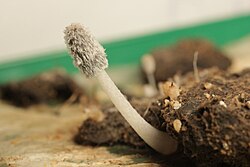| Coprinopsis radiata | |
|---|---|
 | |
| Scientific classification | |
| Domain: | Eukaryota |
| Kingdom: | Fungi |
| Division: | Basidiomycota |
| Class: | Agaricomycetes |
| Order: | Agaricales |
| Family: | Psathyrellaceae |
| Genus: | Coprinopsis |
| Species: | C. radiata |
| Binomial name | |
| Coprinopsis radiata (Bolton) Redhead, Vilgalys & Moncalvo (2001) | |
| Synonyms [1] | |
| |
Coprinopsis radiata, formerly known as Coprinus radiatus, and commonly known as the miniature woolly inky cap, [2] is a coprophilous fungus that grows on herbivore dung. It is heterothallic.